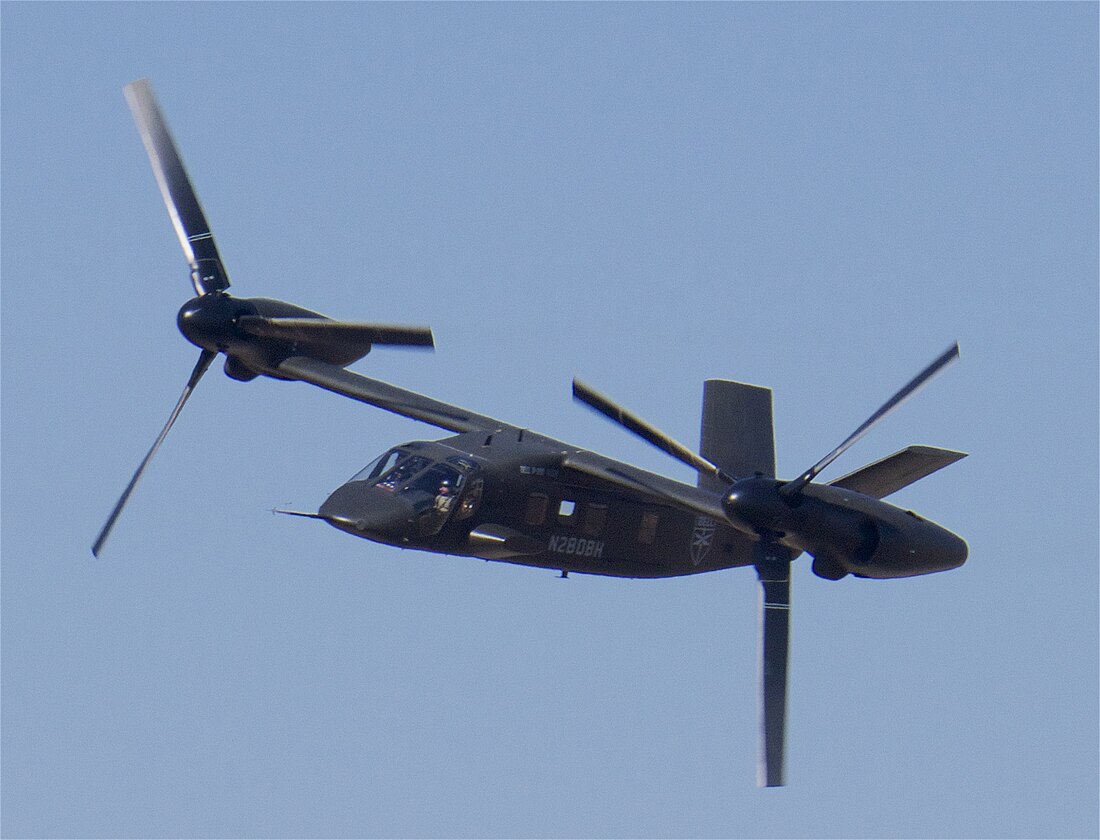Top Qs
Timeline
Chat
Perspective
Future Long-Range Assault Aircraft
US Army helicopter development program initiated in 2019 From Wikipedia, the free encyclopedia
Remove ads
The Future Long-Range Assault Aircraft (FLRAA) program was initiated by the United States Army in 2019 to develop a successor to the Sikorsky UH-60 Black Hawk utility helicopter as part of the Future Vertical Lift program. The UH-60, developed in the early 1970s, has been in service since June 1979. Like the UH-60, FLRAA variants would also serve United States Special Operations Command and the United States Marine Corps. Under the existing Joint Multi-Role Technology Demonstrator (JMR-TD) program, the Army has been gathering data from flying prototype designs that could fill the FLRAA role.
The Army posted a request for information (RFI) in April 2019, which was intended to identify interested manufacturers. According to the RFI, the Army plans to bring the FLRAA into service in 2030, in anticipation of retiring the UH-60 after a 50-year life.
On December 5, 2022, the Army selected the Bell Textron V-280 Valor powered by Rolls-Royce engines for the FLRAA contract award.[1] The award was protested by the Sikorsky-Boeing team,[2] however the Government Accountability Office denied the protest.[3][4]
Remove ads
Design goals
Summarize
Perspective
According to the RFI, the Army has set a per-unit cost goal of $43 million (in 2018 dollars).[5] The Army envisions combat scenarios where a future scout helicopter being developed under the Future Attack Reconnaissance Aircraft (FARA) program and unmanned drones would control an area or corridor, which would then allow FLRAA to insert troops. FLRAA is intended to be more agile and faster than the existing UH-60.[6]
- Notes
- With 30 minute loiter at max payload, using specified mission profiles.
- Specified as true airspeed
- Lower value at 90% maximum continuous power. Higher value at 100% intermediate rated power using specified mission profile.
- Includes 12 personnel: 8 troops, 2 pilots, and 2 crew
- Requirement in addition to aircraft crew.
- 365 lb (166 kg) assumed per passenger
Remove ads
Competition history
Summarize
Perspective

FLRAA is part of the Future Vertical Lift (FVL) program; in 2016, Major General William Gayler declared the first FVL aircraft would fill the medium-lift role.[7] The proposed FLRAA program schedule overlaps with the FARA procurement, which is also part of FVL. FARA would provide a light-lift helicopter for the armed reconnaissance/scout role that was previously filled by the Bell OH-58 Kiowa until its retirement in 2014.[6]
On April 4, 2019, the Army released a formal request for information and outlined its proposed schedule for FLRAA:[5]
- Q4FY21 (Jul–Sep 2021): Award contract
- Q2FY23 (Jan–Mar 2023): Preliminary design review
- Q3FY24 (Apr–Jun 2024): First flight
- Q4FY24 (Jul–Sep 2024): Critical design review
- Q2FY30 (Jan–Mar 2030): First unit enters service
The FVL program is headed by Brigadier General Wally Rugen; according to Rugen, based on the data gathered during JMR-TD with the Bell V-280 Valor and the Sikorsky–Boeing SB-1 Defiant, the Army was ready to move on to open competition for the FLRAA contract.[8] In March 2020, the Army awarded competitive demonstration contracts to Bell and Sikorsky/Boeing, who would proceed to complete conceptual designs and explain how the FLRAA requirements were met by the Valor and Defiant candidate designs, respectively.[9]
On 8 February 2024 the US Army ended development of FARA,[10] while FLRAA development is continuing.[11] FLRAA passed Milestone B in the acquisition process in August 2024.[12]
Remove ads
References
External links
Wikiwand - on
Seamless Wikipedia browsing. On steroids.
Remove ads

